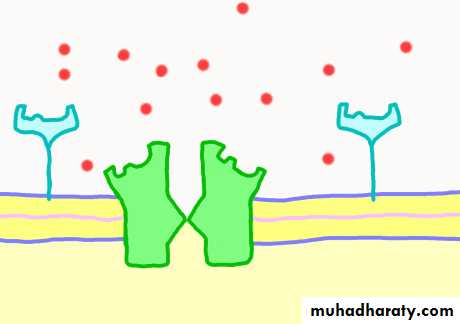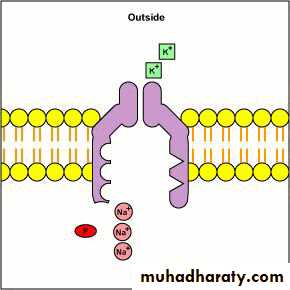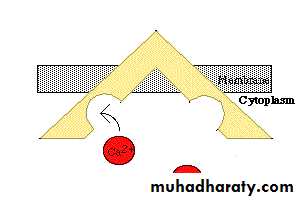Transport through the cell membrane
Transport through the cell membrane either by diffusion or active transportDiffusion
divided into two subtypes called simple diffusion and facilitated diffusionSimple diffusion means that movement of molecules or ions through the cell membrane opening according to concentration gradient
(1) through the lipid bilayer if the diffusing substance is lipid soluble like oxygen, nitrogen, carbon dioxide, and alcohols.
(2) through protein channels that penetrate all the way through the cell membrane
The protein channels are distinguished by two important characteristics:
1-they are often selectively permeable to certain molecules or ions This depend on the diameter, shape, and the nature of the electrical charges2- can opened or closed by gates
a-Voltage gating. In this case opening of the gate responds to the electrical potential across the cell membrane.
example is sodium channel when the inside of the cell membrane is negative, this cause the sodium gates to remain closed; conversely, when the inside of the membrane loses its negative charge, these gates would open suddenly and allows sodium to pass inward through the sodium pores.
b-Chemical (ligand) gating. They are opened by the binding of a chemical substance with them. Example for this is acetylcholine channel.
Facilitated Diffusion
carrier-mediated diffusionsubstance diffuses through the membrane using a specific carrier protein.
glucose and most of the amino acids
Factors That Affect Net Rate of Diffusion
1-Concentration Difference2-The electrical charges of the ions cause them to
move through the membrane even though no concentration difference exists to cause movement.
3-Effect of a Pressure Difference Across the Membrane. The net movement of molecules from the high-pressure side toward the low-pressure side.
Osmosis
Diffusion of Water Across Selectively Permeable Membranes from a region of low solute concentration (high water concentration) to one with a high solute concentration (low water concentration)Water is the most abundant substance that diffuses through the cell membrane
ACTIVE TRANSPORT
movement of a substance from area of low concentration of this substance to the area of high concentration for that substance usually need energyActive transport is divided into two types
primary active transport and secondary active transport
primary active transport
the energy is derived directly from ATPAmong the substances that are transported by primary active transport are sodium, potassium, calcium ,hydrogen, chloride, and a few other ions
Na+-K+ pump
The liberated energy cause a conformational change in the carrier protein ,extruding the three Na to the outside and the two K to the inside.
net of apositive charge is moved to the exterior. This creates positivity outside the cell and negativity on the inside. Therefore, the Na+-K+ pump is called electrogenic.
Calcium pump
the carrier protein has a binding site for CaAnd there is ATPase enzyme to liberate the energy
Calcium ions are maintained at low concentration inside the cell. This is achieved mainly by calcium pumps. One is in the cell membrane and pumps calcium to the outside of the cell. The other pumps calcium ions into the sarcoplasmic reticulum of muscle cells and the mitochondria in all cells.
Hydrogen Ions
primary active transport of hydrogen ions is very important at two places in the body, :
(1) in the gastric glands of the stomach
(2) in the late distal tubules and cortical collecting ducts of the kidneys
In secondary active transport
the energy is derived secondarily from energy that release in simple diffusionSecondary Active Transport…. Co-Transport and Secondary Active Transport ….Counter-Transport
Co-transport
excess sodium outside the cell cause sodium to diffuse to the inside the cell. this diffusion of sodium can pull other substances with the sodium through the cell membrane. This is called co-transport.The carrier in this instance has as an attachment site for both the sodium ion and the substance. Once they both are attached, the energy gradient of the sodium ion causes both the sodium ion and the other substance to be transported together .Co-Transport of Glucose and Amino Acids
C0-transport
counter-transport
sodium attempt to diffuse to the interior of the cell in this time, the substance to be transported is the outside. Once both have bound, a conformational change occurs, and energy released by the sodium ion moving to the interior causes the other substance to move to the exterior.sodium-calcium counter-transport and
sodium-hydrogen counter-transport.
Counter transport
Active Transport Through Cellular Sheets
Transport of this type occurs through the(1) intestinal epithelium,
(2)epithelium of the renal tubules
(3) epithelium of all exocrine glands
(4) epithelium of the gallbladder, and
The basic mechanism for transport of a substance through a cellular sheet is (1) active transport through the cell membrane on one side of the transporting cells in the sheet, and then (2) either simple diffusion or facilitated diffusion through the membrane on the opposite side of the cell.
sodium and water diffuse readily from the lumen into the interior of the cell. Then, at the basal and lateral membranes of the cells, sodium ions are actively transported into the extracellular fluid of the surrounding connective tissue and blood vessels.
water diffuses from a region of low solute concentration (high water concentration) to one with a high solute concentration (low water concentration)
Active transport
ligand
Voltage
Open and close by gate
selective
Counter transport
Co-transport
Secondary transport
Primary active transport
Facilitated diffusion
Simple diffusion
Diffusion
Transport through the cell membrane
Cell memb. pores
Protein channels












